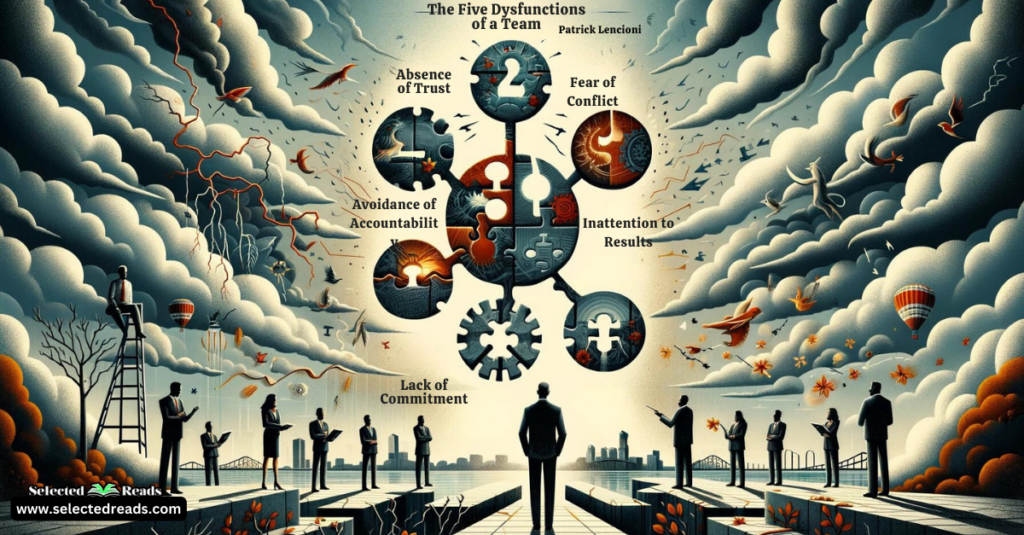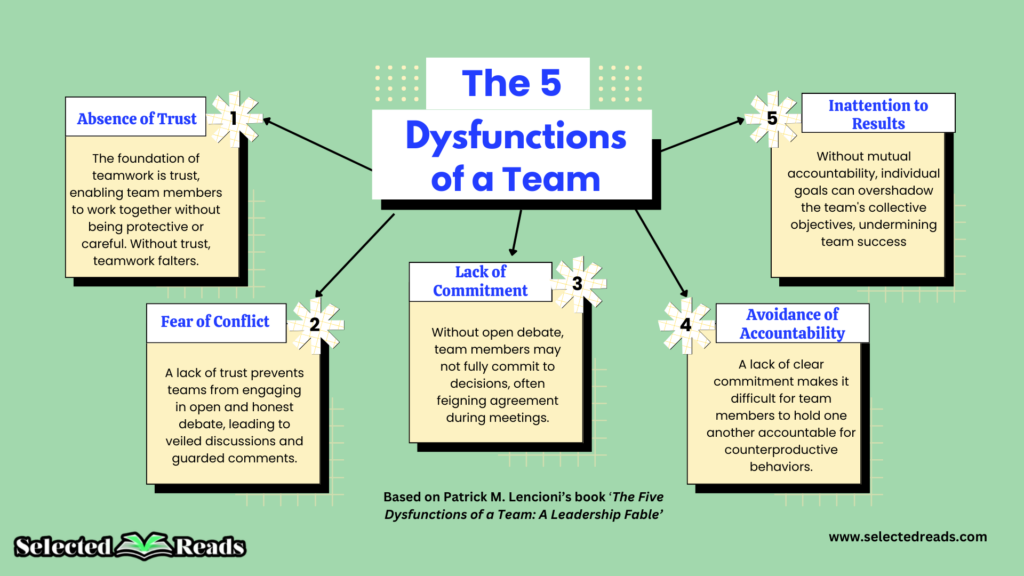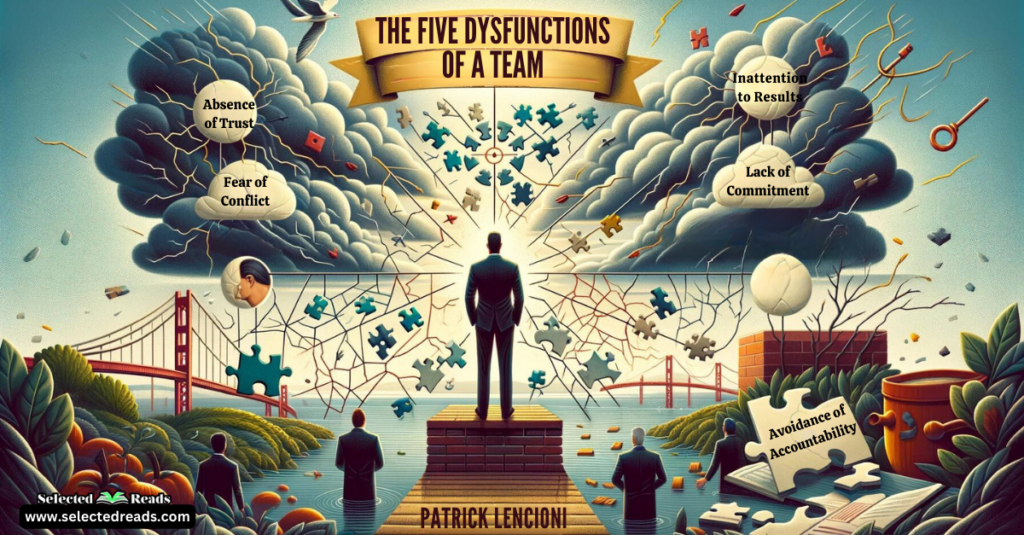In the dynamic realm of team management and leadership, “The Five Dysfunctions of a Team: A Leadership Fable” by Patrick M. Lencioni stands as a pivotal guide that delves into the intricacies of team dynamics and the hurdles that prevent a team from achieving its full potential. This book, through the engaging narrative of Kathryn Petersen and her journey as the CEO of DecisionTech, offers profound insights into the challenges and triumphs of leading a team towards success.
In this post, we will explore an extended summary of the book, introduce the key characters such as Kathryn Petersen, Jeff Shanley, Michele (Mikey) Bebe, and others who bring the story to life, and provide a set of thought-provoking book club questions designed to deepen your understanding and application of the book’s lessons.
Related: The Five Dysfunctions of a Team Quotes
The Five Dysfunctions of a Team Summary
If business literature is your cup of tea, Patrick Lencioni’s “The Five Dysfunctions of a Team:” is definitely a book you don’t want to miss. I have read it twice and each readings uncovers new insights. The book blends a gripping narrative with insightful leadership wisdom.
This book, a stalwart on bestseller lists, has captivated readers with its unique approach to dissecting team dynamics through the story of Kathryn Petersen, the newly appointed CEO of DecisionTech. Lencioni’s work stands out not just for its engaging storytelling but for the profound lessons it embeds within the fabric of its narrative.
At the heart of the book is Kathryn Petersen’s journey as she grapples with the challenge of her career: turning around a dysfunctional executive team that is threatening to pull the company apart.
It’s a scenario many in leadership positions can relate to, making the story not just a fable but a reflection of real-world organizational challenges. Lencioni crafts his narrative around Kathryn’s strategic moves, her insights into team behavior, and her unyielding commitment to unity, which she pursues with a blend of determination and empathy that’s both inspiring and instructive.
What Are the Five Dysfunctions of a Team According to Patrick Lencioni?
The core of Lencioni’s thesis is encapsulated in the model of the five dysfunctions that he argues are the root causes of why teams fail. These are:
- Absence of Trust: The foundation of teamwork is trust, the confidence among team members that their peers’ intentions are good and that there is no reason to be protective or careful around the group. Without trust, teamwork is all but impossible.
- Fear of Conflict: Teams that lack trust are incapable of engaging in unfiltered and passionate debate of ideas. Instead, they resort to veiled discussions and guarded comments.
- Lack of Commitment: Without having aired their opinions in the course of passionate and open debate, team members rarely, if ever, buy in and commit to decisions, though they may feign agreement during meetings.
- Avoidance of Accountability: Without committing to a clear plan of action, even the most focused and driven people can hesitate to call their peers on actions and behaviors that seem counterproductive to the good of the team.
- Inattention to Results: Failure to hold one another accountable leads to putting individual needs (such as ego, career development, or recognition) or even the needs of divisions above the collective goals of the team.
Lencioni doesn’t just stop at identifying these dysfunctions; he goes further to offer a roadmap for overcoming them, turning theoretical insights into practical steps that leaders can apply within their own teams. This guide is what sets the book apart as a tool, not just for understanding team dynamics but for actively improving them.
In essence, “The Five Dysfunctions of a Team” transcends its business fable format to offer timeless wisdom on leadership and teamwork. It’s a book that resonates with anyone who believes in the power of collective effort, making it a must-read not just for corporate leaders but for educators, coaches, and leaders in all walks of life who strive to bring out the best in their teams.
The Five Dysfunctions of a Team Characters
In “The Five Dysfunctions of a Team,” Patrick Lencioni uses a fictional but highly relatable story to illustrate the team dynamics and dysfunctions. The main characters in this narrative are part of DecisionTech, Inc., and each plays a critical role in unfolding the story and the lessons it imparts. Here’s a brief overview of the key characters and their roles within the company:
- Kathryn Petersen: The central character, Kathryn is the newly appointed CEO of DecisionTech, Inc. She is brought in to solve the company’s problems and unify the team. Her leadership and actions throughout the story serve as a vehicle for Lencioni to explore and address the five dysfunctions.
- Jeff Shanley: The former CEO and co-founder of DecisionTech, who transitions to a role focusing on business development. Jeff’s struggle with letting go of control and his reactions to Kathryn’s leadership provide insights into the challenges of leadership transition and trust.
- Michele (Mikey) Bebe: The head of marketing. Mikey is a character who often challenges Kathryn and illustrates the dysfunction of a lack of commitment and fear of conflict through her actions and skepticism.
- Martin Gilmore: The chief technologist (CTO) and the only executive not from a business background. Martin’s character emphasizes the importance of intellectual engagement and shows how a lack of conflict can signify an absence of trust and commitment.
- Jeff (JR) Rawlins: The head of sales. JR’s behavior exemplifies the avoidance of accountability, as he tends to deflect blame and avoid confronting issues directly.
- Carlos Amador: The head of customer support. Carlos often plays a mediator role, highlighting the need for constructive conflict and demonstrating the challenges of fostering commitment and accountability within a team.
- Jan Mersino: The chief financial officer (CFO). Jan’s character is less confrontational but her interactions with the team highlight the nuances of building trust and the consequences of avoiding accountability.
The Five Dysfunctions of a Team Book Club Questions
Here are some thought-provoking questions to facilitate deep discussions and reflections among book club members:
- Reflection on Personal Experiences: Have you ever been part of a team that exhibited any of the five dysfunctions? Share your experiences and how those dynamics affected the team’s performance.
- Understanding Trust: Why is trust considered the foundation of a functional team? Discuss ways teams can build and maintain trust, and share examples from the book where Kathryn worked to build trust among her team.
- Conflict as a Growth Tool: The book suggests that fear of conflict is a dysfunction. Can you think of instances where conflict led to positive outcomes in the story? How can teams ensure that conflict remains constructive?
- Commitment and Clarity: Lencioni points out that a lack of commitment stems from ambiguity and fear of failure. How does Kathryn address these issues to foster commitment from her team? Discuss the importance of clarity and buy-in for team success.
- Accountability in Practice: Avoidance of accountability can cripple a team. How does Kathryn encourage her team to hold each other accountable? Can you think of ways to implement a culture of accountability based on the book’s insights?
- Focus on Collective Outcomes: Inattention to results is highlighted as a major dysfunction. Discuss how individual agendas can derail team objectives, using examples from DecisionTech. How does the book suggest teams can align their goals?
- Character Analysis: Which character did you relate to most, and why? How did their journey through the book reflect on the dysfunctions and their resolutions?
- Leadership Lessons: Kathryn’s leadership style is central to addressing the team’s dysfunctions. What qualities make her effective? Are there any criticisms of her approach?
- Applying the Model: How can Lencioni’s model be applied in different settings, such as non-profits, educational institutions, or volunteer groups? Discuss the universality of the five dysfunctions.
- Critique and Alternatives: Do you see any limitations or challenges in applying Lencioni’s model to real-world teams? Are there situations where the model might not be as effective?
- Personal Takeaways: What are the key lessons you’ve taken from the book that you can apply to your own team experiences? How has the book changed your perspective on teamwork and leadership?
- Next Steps for Growth: Based on the book’s insights, what are some steps you or your organization can take to address these dysfunctions and foster a healthier team environment?
Final thoughts
Patrick M. Lencioni’s “The Five Dysfunctions of a Team: A Leadership Fable” offers a transformative journey into the heart of team dynamics and leadership. With its compelling narrative intertwined with practical, actionable insights, this book stands as an essential read for anyone looking to understand the complex nature of team performance and leadership.
Lencioni masterfully blends storytelling with a deep understanding of organizational behavior, making the lessons not only accessible but deeply resonant. As a guide to building stronger, more cohesive teams, it’s packed with wisdom that’s applicable across a wide range of contexts.
Whether you’re leading a small team or managing at the executive level, the insights within these pages offer a roadmap to overcoming common pitfalls and fostering a culture of success and collaboration. Truly, “The Five Dysfunctions of a Team” is a treasure trove of knowledge, making it a must-read for those committed to the art and science of team building.









